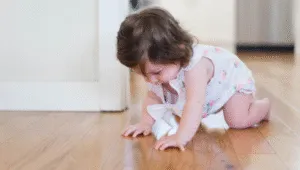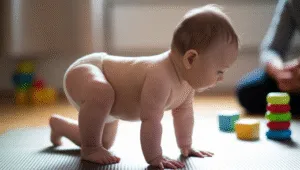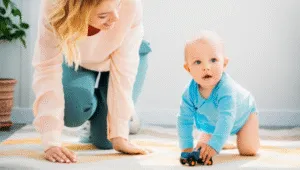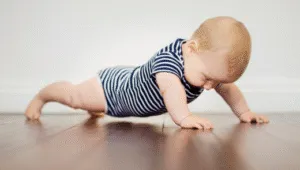Working with families in pediatric physical therapy, many parents would ask to explain why their little one wasn’t crawling yet, especially when their baby seemed eager to jump straight to walking. What most families don’t realize is that crawling serves as a crucial foundation for countless skills that develop throughout childhood. This milestone, which typically develops between 6 and 10 months, is far more than just a step toward independent mobility – it’s a complex neurological development process that helps a child coordinate their limbs, strengthen core areas, and build the balance needed for future physical achievements.
Skipping this vital stage can have significant impacts on a child’s ability to develop essential skills like feeding, dressing, coloring, playing with toys, learning to write, and managing daily experiences. Crawling provides unparalleled exposure to gross motor development while simultaneously laying the groundwork for fine motor skills and speech development. When a baby starts and spends adequate time each day on the floor without relying on positioning devices, they naturally progress through rolling and eventually to crawling, which builds essential core strength and coordination.
Occupational therapy and physical therapy professionals consistently promote floor-based experiences because this progression allows children to strengthen multiple muscle groups simultaneously. This skill ensures that when trouble emerges or developmental delays in occupational therapy become apparent, early intervention through specialized therapy can help guarantee that each child receives the support they need to reach their full potential, making crawling an indispensable component of healthy childhood development.

What Does Crawling Mean?
Crawling represents the first form of independent locomotion that a baby experiences during a critical period of childhood development, involving the distribution of weight across hands and knees to build essential strength and stability for future walking abilities. This fundamental movement pattern helps develop crucial balance mechanisms while stimulating the sensory system, enhancing cognition and problem-solving skills, as infants demonstrate remarkable coordination navigating through space. There are two main types of crawling patterns: the belly crawling motion (often called army crawling) and the traditional four-point crawling position, where children support themselves on hands and knees.

What Does Belly Crawling Look Like?
Belly represents a type of locomotion where babies begin their movement journey by keeping their torso against the floor while simultaneously pulling themselves forward using their arms to pull one side of the body in an alternating pattern with their legs. This army-style movement pattern, which many infants tend to develop, is often faster than four-point crawling because it requires significantly less strength and balance to master, making it a preferred method of locomotion during the transition phase before walking develops. Belly crawling is common and functional; it’s not always necessary for typical development, as some children skip this stage entirely and move directly to hands-and-knees crawling.
Understanding Four-Point Crawling Movement
- Four-point crawling occurs when a baby places both hands and knees on the floor while coordinating complex movements to produce forward locomotion using this advanced method.
- In this reciprocal pattern, the infant learns to alternate between right and left legs and arms, where one hand will meet the time requirements of moving with the opposite leg in a synchronized sequence that demonstrates sophisticated motor control.
- This coordinating movement is particularly important for cognitive development because it requires the brain to communicate across both hemispheres, establishing neural pathways that support future learning and bilateral coordination skills that are essential for academic readiness in therapeutic practice.
What Other Crawling Variations Exist?
- Experts have observed over 25 unique combinations of body movements that babies use to crawl, including alternative methods like scooting on their bottom, using one foot and one knee to push and pull themselves forward, crab walking, leap frogging, and repetitive rolling to achieve locomotion.
- These alternative and common forms of movement often indicate difficulty coordinating the complex movements required for traditional four-point crawling, which is where a pediatric physical therapist can help families understand developmental variations and encourage proper movement patterns.
- While these creative locomotion strategies demonstrate problem-solving abilities, it’s important to start recognizing when intervention might be needed to ensure children gain the associated benefits of traditional crawling patterns that support optimal neurological and physical development.
What Makes Crawling So Essential for Development?
Physical Foundation Building
- Crawling builds crucial stability and strength in the trunk, arms, and legs while developing essential gross motor skills that prepare children to walk.
- This movement pattern helps strengthen key muscles and allows infants to master balance through strengthening hand and finger coordination, which increases shoulder stability during four-pointlocomotion.
- This position helps organize and shape the hip joint as the leg bone (femur) fits properly into the socket (acetabulum), allowing the hips to reshape as babies pull their bones forward and inwards into the correct anatomical position for standing and walking.
Fine Motor and Coordination Development
- The weight-bearing aspect of crawling significantly impacts fine motor skills by improving holding abilities for utensil use, writing implements, and manipulating small objects while strengthening the abdomen for better breathing, talking, and eating functions.
- Crossing the midline creates essential brain connections across an imaginary line drawn down the middle of the body, allowing arms and legs to work together effectively.
- This builds neural connections that are beneficial for later life fine motor skill development, vision, hearing, learning, and handwriting abilities through primitive reflex integration and mind-body coordination.
Bilateral Coordination and Brain Communication
- Bilateral coordination develops as the left and right sides of the body work together during daily activities like coloring on paper, dressing, playing, and walking with proper form.
- This movement requires children to move the opposite arm and leg simultaneously, forcing both brain hemispheres to communicate effectively.
- This communication takes place in a specific area called the corpus callosum, a band of nerve fibers located between the two hemispheres that helps both sides coordinate, serving as a stepping stone for advanced motor skills like running, riding a bike, getting dressed, and other self-caredevelopment tasks.
Sensory System Integration
- Crawling provides rich sensory experiences by using five different sensory systems, including the skin, muscles, joints, ears (through the inner vestibular system), and eyes, to process multiple levels of sensory information.
- This helps children understand how their body fits in space and interacts with objects around them while developing postural control – the ability to remain upright in space.
- As babies learn to contract different muscles, they increase their postural control to remain upright while playing, moving, and eating.
Motor Planning and Body Awareness
- Motor planning develops as the brain remembers and performs the steps needed to complete and make any movement happen, helping children develop a comprehensive body map that leads to an easier time learning and performing movements.
- This process helps connect the brain to fingers for fine motor skills development, creating a significant impact to improve a child‘s grasp ability to hold and use items, including eating utensils like spoons and forks, plus writing utensils such as crayons and pencils.
Hand Development and Visual Skills
- The development of arches and proper layout of the hand occurs as children develop functional arches in their hands along with the web space for thumb opposition, allowing the thumb to move across the palm and touch other fingers.
- This is important for holding and using tools and utensils effectively.
- Additionally, visual system development occurs as crawling helps strengthen muscles in the eyes, allowing increased control over eye movements as the child explores and looks around their surroundings, creating a positive impact on visual perception skills, depth perception, and spatial awareness as they crawl and explore to see and feel big and small, far and away things.

Does Crawling Count as a Key Developmental Achievement?
Learning to crawl is considered an important developmental milestone, though skipping this stage is not always bad or harmful, which is why crawling should still be encouraged even if a child learns to walk without it due to the benefits mentioned above. In typical cases, a baby should be able to crawl at about 9 months, though children with different developmental disorder conditions like cerebral palsy or Down syndrome may follow alternative pathways.
What Happens When a Child Skips the Crawling Stage?
When little ones skip the crawling stage, research suggests that babies who don’t engage in this crucial movement pattern may fall behind in essential motor skills development and exhibit learning difficulties later in life. The benefits of crawling are missing when this stage is skipped, which can cause issues with both fine and gross motor coordination that are discussed above as essential for a child’s physical progress.
If a baby isn’t crawling by 9 months, it’s a good idea to see a licensed therapist who can assess for underlying problems and learn strategies to help. Make sure to understand that lacking this foundational experience creates challenges that persist later, so recognizing these early warning signs allows us to implement targeted interventions.
Essential Movement Development Strategies
Foundation Building Through Floor Work
- Provide extended floor time to allow your baby to naturally explore and move their body
- Expose babies to varied tummy positioning while awake during playing sessions
- Use a soft towel strategically placed under the chest area to prop and give support
- Position elbows directly under shoulders to make sure they can effectively push and promote strength
Environmental Optimization for Development
- Decrease the time spent holding and constantly propping your child in upright positions
- Limit dependency on movement-restricting containers such as Bumbo seats, exercise saucers, Dock A Tots, or anything that restricts natural body movement
- Minimize excessive use of child carriers to encourage independent crawling development
- Create obstacles using pillows, a box, or furniture to promote climbing over challenges
Strategic Positioning and Motivation Techniques
- Place colorful toys at the front during tummy time to practice reaching movements with arms
- Position motivating toys to the side to encourage twist and turn body mechanics
- Put highly favorite toys approximately 3 feet away from your toddler to encourage work towards wanting to crawl forward
- Get children actively crawling by placing objects underneath table, bench, or chair structures
Interactive Play and Skill Building
- Demonstrate hands-on crawling techniques in front of your baby to provide visual learning opportunities
- Encourage toddlers to crawl inside and under different structures, like a tunnel toy
- Use push toys, including toy cars, while crawling and driving across roads made with tape on the floor
- Play pretend games where children imitate different animals during crawling activities
- Give much support through legs and feet positioning as needed during exercise routines

Common Parent Questions
When should my baby start crawling, and what if they skip this stage?
Most babies begin crawling between 6-10 months as a crucial milestone. Children who skip crawling may fall behind in essential motor skills and exhibit learning difficulties later in life. Encourage crawling even after walking develops.
How does crawling impact fine motor skills and handwriting?
Crawling significantly impacts fine motor skills by improving holding abilities for utensil use and writing implements. This movement helps connect the brain to fingers for development, creating an impact to improve grasp ability.
What problems arise when babies don’t get enough tummy time?
Inadequate tummy time can cause issues with both fine and gross motor coordination. Babies need floor time to strengthen muscles, develop balance, and build neural connections essential for future learning and physical progress.
How does crawling help with brain development and coordination?
Crawling requires both brain hemispheres to communicate effectively through the corpus callosum. This bilateral coordination develops as the left and right sides work together, creating neural pathways beneficial for vision, hearing, learning, and handwriting abilities.
What sensory experiences does crawling provide for development?
Crawling gives a different movement experience through floor play. This encourages babies to use arms and legs while exploring toys and objects.. This helps children understand how their body fits in space and develop postural control for eating, playing, and moving.
Final Thoughts on Crawling Development
Crawling serves as a crucial foundation for countless skills that develop throughout childhood, building essential strength and coordination. This milestone helps children develop balance, strengthen core areas, and create neural connections beneficial for learning and physical achievements. Skipping this vital stage can have significant impacts on a child’s ability to develop skills like feeding, dressing, coloring, and writing. Early intervention through specialized therapy can help guarantee each child receives the support they need to reach their full potential.
